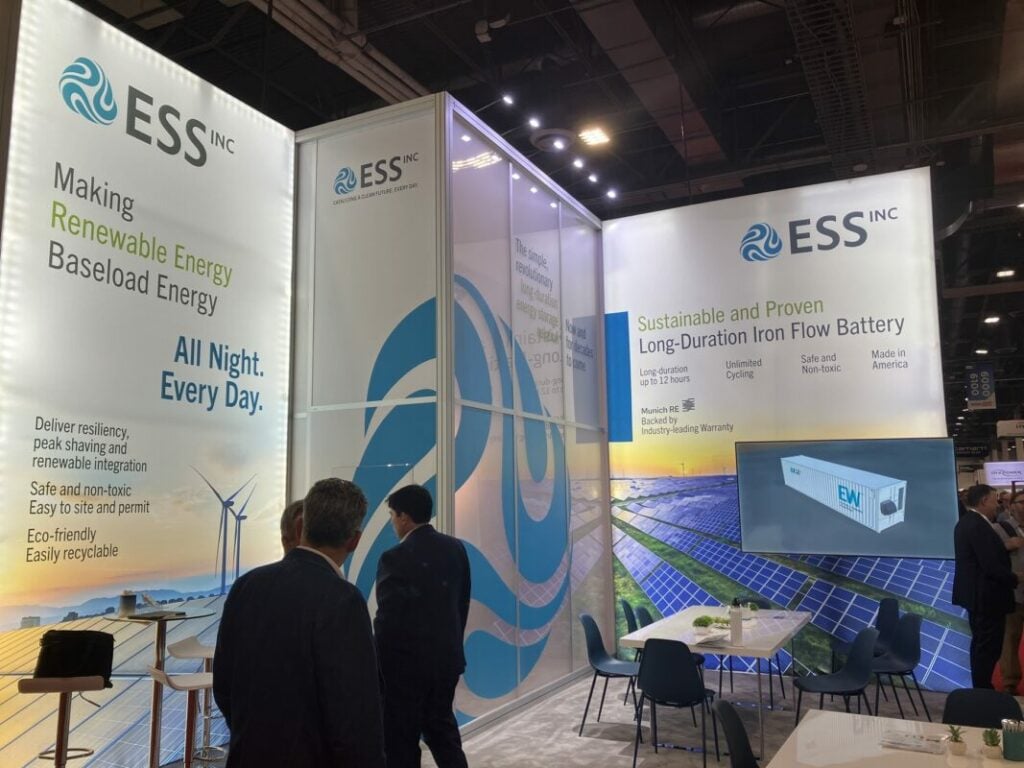
Updated 29 September 2023: Following publication of this story, ESS Inc responded to a couple of Energy-Storage.news’ enquiries. The company said the partnership with Honeywell encompasses ESS Inc having access to Honeywell’s IP on iron flow batteries. In the process, it was revealed that the flow battery Honeywell has been developing and working on is also based on an iron electrolyte chemistry.
US engineering and automation solutions firm Honeywell has partnered with ESS Inc, manufacturer and IP holder of an iron electrolyte flow battery technology.
Enjoy 12 months of exclusive analysis
- Regular insight and analysis of the industry’s biggest developments
- In-depth interviews with the industry’s leading figures
- Annual digital subscription to the PV Tech Power journal
- Discounts on Solar Media’s portfolio of events, in-person and virtual
Honeywell is investing US$27.5 million into the Oregon-headquartered technology provider and has agreed to purchase up to US$300 million worth of the proprietary systems, beginning with an initial US$15 million.
Honeywell is seeking to establish a foothold in the emerging market for long-duration energy storage (LDES) which was described as a “compelling market opportunity in the energy transition” by Honeywell Performance and Technology Materials Group chief growth officer Bryan Glover in an announcement made on Monday (25 September).
The pair will also collaborate on the development of the technology. Most other commercially available flow batteries use metal vanadium as the key element in their electrolyte, although others exist, such as zinc bromine chemistry electrolytes.
ESS Inc meanwhile is the only manufacturer of the iron chemistry due to its hold on the IP. The electrolyte mostly comprises iron and saltwater and the company has claimed that this makes it non-flammable as well as being a less toxic mix than electrolyte used in other flow technologies.
What it does have in common with other flow batteries is that the battery is rugged and durable, designed to experience minimal degradation in the battery stack even over many years and heavy cycling.
These qualities are often touted as advantages over lithium-ion and even other types of electrochemical storage, but also the fact that electrical energy is stored in tanks of liquid electrolyte mean that power and energy can be decoupled.
That allows for scaling up systems to large capacities and durations of energy stored and at the recent RE+ 2023 trade event in Las Vegas, representatives of ESS Inc’s fellow flow battery providers Invinity Energy Systems and Redflow said the levelised cost of storage (LCOS) of the technologies will be lower over a project’s lifetime than comparably sized lithium-ion battery energy storage system (BESS) assets.
One other aspect of the Honeywell-ESS Inc agreement is that they will work together to develop the technology further. Honeywell is already highly active in the battery energy storage system (BESS) integration space, while its expertise spans a broad range of other relevant areas.
A release from ESS Inc said the patented iron flow battery (IFB) design will be brought together with Honeywell’s knowhow in advanced materials and energy systems.
During this year, ESS Inc, which is publicly traded, has announced a handful of key customer deals, the single biggest project among them being a 50MW/500MWh (10-hour duration) project in Germany with utility LEAG. In addition to producing systems at its own factory in the US, the company has licensed its technology to ESI Asia-Pacific, a partner based in Australia.
LDES is an ‘unavoidable topic’ as renewable penetration grows
ESS Inc CEO Eric Dresselhuys, speaking with Energy-Storage.news at the RE+ 2023 trade event earlier this month, said that the energy industry is waking up to both the opportunity and need for LDES. While his comments – to be published in full in an interview in the coming days – pre-dated Bryan Glover’s quote on the market opportunity, they perhaps serve to illustrate the point.
ESS Inc has been in existence for over 10 years and so has its technology. Dresselhuys joined two and a half years ago and in that time “all of the macro things have gotten better,” he claimed.
“We haven’t changed our strategy, our product, which a lot of people have… We’ve stayed with our technology, we like our technology,” Dresselhuys said.
“We think it has great long-term advantages, and all of the macro market drivers have gotten better, substantially better, in the last two and a half years since I’ve joined.”
The CEO referred to the company’s membership of the global trade group Long Duration Energy Storage Council (LDES Council) as helping push forward the collective voice of companies in the space.
Yet impetus for everything from the LDES Council’s formation to the announcement a few days ago that the US Department of Energy (DOE) will put US$325 million funding into supporting nine different LDES projects speaks to the true driver: the energy transition to decarbonise and the growth of renewable energy.
“As we get to higher and higher levels of renewable penetration people are… we said this from the beginning: when you have relatively low, single digit or low teens, renewable energy penetration, storage in general, kind of doesn’t really hit your radar screen that much too,” Dresselhuys said.
“And certainly long-duration storage seems like a [question of], ‘I don’t even know what problem I’m solving [with it]’. As you get to 25% penetration or more and as you start to think about the long term plan, how do I draw a map to get all the way there? It becomes unavoidable. It’s kind of funny to read but it just kind of flips [peoples’ thinking].”
What’s happening with Honeywell’s own flow battery?
One question that regular readers of Energy-Storage.news might be left with is what sort of position this leaves Honeywell’s own proprietary flow battery technology, which it soft launched back in 2021.
After a couple of teasers including mentions of a long-duration technology in development on an Energy-Storage.news webinar, Honeywell officially announced in October 2021 that its flow battery was ready. It would be used in a pilot project by Duke Energy in a 400kWh configuration, to be deployed in 2022, the company said at the time.
However, there appear to have been no updates since then on that pilot project, which if all went well would have been scaled up into the megawatt-hour scale later on.
In an interview conducted at that time with this site, Honeywell Sustainable Technology Solutions (Honeywell STS) vice president and general manager Ben Owens said the tech had the ability to scale up, but he and the company never revealed the chemistry of the battery’s electrolyte beyond stating that it was made with abundant, “easy to source” materials.
Energy-Storage.news has asked Honeywell representatives for an update on the company’s own flow battery and will update this story in due course. Even at the time it was ‘unveiled’ in 2021 however, Honeywell said that it was entering the space in response to the energy sector’s need for long-duration storage.






